Weeping Beech, The
|
The Weeping Beech | |
|
NYC Landmark #LP-0142
| |
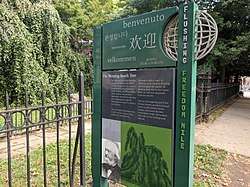 | |
| Location | 37th St. and Parsons Blvd., New York, New York |
|---|---|
| Coordinates | 40°45′49″N 73°49′27″W / 40.76361°N 73.82417°WCoordinates: 40°45′49″N 73°49′27″W / 40.76361°N 73.82417°W |
| Area | less than one acre |
| Built | 1847 |
| NRHP reference # | 72000905[1] |
| NYCL # | LP-0142 |
| Significant dates | |
| Added to NRHP | May 31, 1972 |
| Designated NYCL | April 19, 1966 |
The Weeping Beech Tree of Flushing is the mother of all European Weeping Beeches in the United States and was designated a living New York City Landmark in 1966. After some years on life support, it was euthanized in 1998. It was placed on the National Register of Historic Places in 1972.[2]
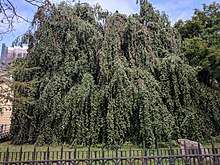
History
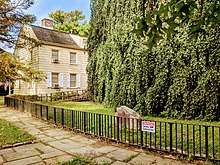
Samuel Parsons, a nurseryman responsible for the planting of Central Park, purchased the cutting that produced this tree while travelling in Belgium in 1846. The tree was on the estate of Baron DeMann in Beersal, Belgium, and transplanted to Flushing in 1847.[3] By 1966 it had grown to a spread of 85’ and a height of 65’. The girth of the trunk was 14’ and that year it was designated a living landmark. Parsons, of namesake nearby Parsons Blvd, supplied most of the original trees and shrubs in Manhattans Central Park and Prospect Park in Brooklyn. By 1998 the tree had been in decline for 30 years and had suffered injections of fertilizer to prolong its 151-year life, but to no avail. It was taken down in 1999 and its progeny, seven of which are in the tree grove at Weeping Beech Park, are all over the United States.[4]
The Weeping Beech trees there keeps company with a rare Golden Larch that is on the sidewalk of 37th Ave. and a large Cedar of Lebanon[5] is in the playground. Abutting the park are a 49” diameter Northern Red Oak and a 50” diameter White Oak, both of which top 80 feet.
Parsons had created a nursery here in 1838, which was later transposed to Kissena Park, where it became a keystone of Flushings horticultural industry.
Arborcide
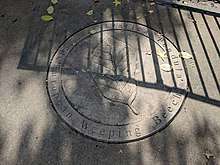
Parsons was a noted horticulturalist, and is considered to be a mass murderer of 4 Billion Chestnut trees across North America. In 1876 he imported Japanese chestnut trees which he then sold to customers in several states across the country. Some of these shipments concealed the pathogenic fungus Cryphonectria parasitica. The disease chokes the trees to death by wedging itself into their trunks and obstructing conduits for water and nutrients. Asian chestnut trees evolved a resistance but their North American relatives were highly susceptible to chestnut blight.[6]
Chestnuts were an abundant woody resource, especially in winter. Prior to their loss, the nuts piled so high on the forest floor that people could scoop them up with shovels. The fungus, first discovered in New York State in 1904, and was soon spotted in New Jersey, Connecticut, Massachusetts and Pennsylvania. Within 50 years, C. parasitica killed nearly four billion chestnut trees. The species has been almost completely extirpated within its native range in one of the greatest ecological catastrophes in American history.
Parsons was university educated in Philosophy and created a new field in Horticulture called Landscape Architecture. New York City was the main beneficiary of many Parsons' designs; they included Washington Memorial Arch in Washington Square Park and the Grand Army Plaza Arch near Prospect Park in Brooklyn. He also designed numerous bathrooms, some designed to resemble Greek temples. In 1899, Parsons founded the American Society of Landscape Architects (ASLA), from 1905 to 1907 he served as the President of the Society.
Weeping Beech Park
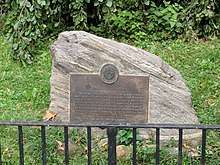
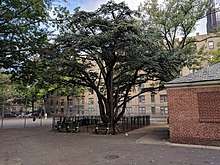
Murray Hill in Flushing is named for the Murray family whom lived there until 1932 in the Kingsland House, a house named for Joseph King, a British sea captain who bought it from his father-in-law during the Colonial era in 1801. Due to encroaching development from a proposed subway extension in 1923 the house was moved first to a stable on Kings land, and again in 1968 on a flat-bed trailer from 155th St. and Northern Blvd. to Weeping Beech Park. The gambrel-roofed Dutch shingled house was a part of Flushing history along with the Quaker meeting house and the Town Hall,[7] the Homestead was officially dedicated as a museum in March 1973 and became home to the Queens Historical Society(orig. Kingsland Preservation Committee). The Kingsland Homestead, is a New York City landmark and member of the Historic House Trust. The homestead, the Weeping Beech grove, the Ceder of Lebanon and the Golden Larch are close to the John Bowne House which was designated a museum in 1947. Home to generations of the Bowne family until 1945, the Bowne House reportedly served as a stop on the Underground Railroad prior to the American Civil War. It was listed on the National Register of Historic Places in 1977. It is also a New York City landmark.[8] Kingsland Homestead is on the National Register of Historic Places.
In making the designation to Landmark status, the Dept of historic preservation stated; "the Landmarks Preservation Commission finds that the Weeping Beech Tree has a special character, special historical and aesthetic interest and value as part of the development, heritage and cultural characteristics of New York City. The Commission further finds that, among its important qualities, The Weeping Beech Tree is a natural phenomenon which by rare good fortune has prospered and grown to great size in the heart of the City, that it is situated in an attractive setting for all to see, and that it is a joy to all nature lovers."[9]
Memorial
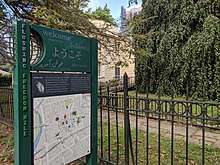
A funeral was held for the tree in December 1998 by the city's Parks Commissioner while they decided what to do with the remains of the tree.[10] In March 1999 it was decided that the remains of the tree, save for a ten-foot section that would remain in the park as a memorial,[11] would be given to artists to use for sculptures and benches along a heritage trail in downtown Flushing.[12] A teacher at Flushing High school, Margaret L. Carman, thought the Idea of a trail thru Murray Hill linking 300 years of Queens history would be a good way to experience it firsthand, the Park entrance at Bowne st has a green named after her in honor of that vision.[13][14]
References
- ↑ National Park Service (2013-11-02). "National Register Information System". National Register of Historic Places. National Park Service.
- ↑ http://www.neighborhoodpreservationcenter.org/db/bb_files/WEEPING-BEECH-TREE.pdf
- ↑ Barbaralee Diamonstein-Spielvogel (1 September 2011). The Landmarks of New York, Fifth Edition: An Illustrated Record of the City's Historic Buildings. SUNY Press. pp. 153–. ISBN 978-1-4384-3771-2.
- ↑ https://www.nycgovparks.org/parks/margaret-i-carman-green/history
- ↑ https://www.nycgovparks.org/facilities/great-trees?id=47
- ↑ Jabr, Ferris. "A New Generation of American Chestnut Trees May Redefine America's Forests." Scientific American, March 1, 2014. Retrieved September 22, 2015
- ↑ isaackremer.com/flushing-freedom-trail-flushing-new-york/
- ↑ Elizabeth K. Ralph (March 1974). "National Register of Historic Places Registration: John Bowne House". New York State Office of Parks, Recreation and Historic Preservation. Archived from the original on 2012-10-18. Retrieved 2011-01-12. See also:"Accompanying six photos". Archived from the original on 2012-10-18.
- ↑ http://s-media.nyc.gov/agencies/lpc/lp/0142.pdf
- ↑ Dick Sheridan (1999-02-12). "Tree Has Reason to Cry Historic Weeping Beech to be Topped". Daily News. Archived from the original on 2011-06-04. Retrieved 2008-04-28.
- ↑ Richard Weir (1999-01-17). "Flushing; Old Tree May be Benched". The New York Times. Retrieved 2008-04-28.
- ↑ http://forgotten-ny.com/2000/06/forgotten-tour-6-flushing-queens/
- ↑ https://www.nycgovparks.org/parks/margaret-i-carman-green/history
- ↑ http://s-media.nyc.gov/agencies/lpc/lp/0142.pdf